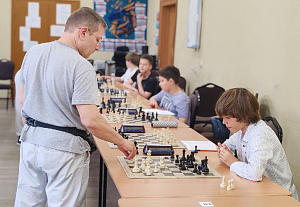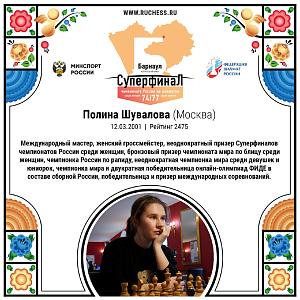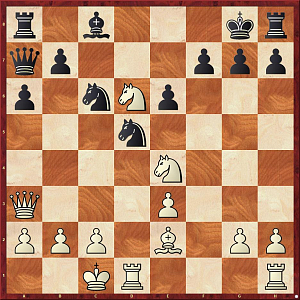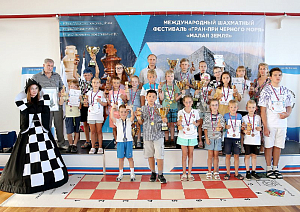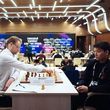20 February 2016
Raining on Carnival is no Big Deal
Day two of the Zurich Chess Challenge 2016 in the review of Vladimir Barsky.
Raining on carnival is no great deal indeed! On Saturday and Sunday the main streets and squares of Zurich heard a lot of music, saw people walking around in costumes and masks – this is how the townspeople were having fun and enjoying life those days. Meanwhile, a stone's throw away from them, at the premises of the "Savoy" hotel, the chess battles were at full swing, while all that was happening at a huge spate of spectators. During the last weekend each resident and visitor of Zurich didn’t fail to find an entertainment to his or her liking!
The former World Champion Vishy Anand has retained the lead, even though with great difficulty: in round three he was close to defeat in a duel with the rival whom he competed against 16 years ago in the course of the world championship match.
Anand – Shirov
Ruy Lopez
1.e4 e5 2.Nf3 Nc6 3.Bb5 a6 4.Ba4 Nf6 5.d3 d6 6.c3 g6 7.0-0 Bg7 8.Nbd2 0-0 9.Re1 Nh5 10.Nf1 f5 11.Ng3 fxe4 12.Bb3+ Kh8 13.Ng5 Nf4 14.Nf7+ Rxf7 15.Bxf7 Qf8 16.Bb3 exd3 17.Bc4 d5 18.Bxd3
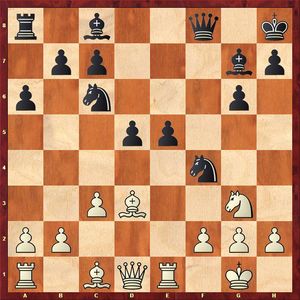
18…e4?!
The positional sacrifice of exchange, carried out by Black, has resulted in a sharp position of dynamic equality, in which Black needed to complete his development first - 18...Be6 19.Bc2 Rd8, yet delaying the central operations for a time being.
19.Bf1
White had a nifty shot at his disposal 19.Bc2 Be6 20.Nxe4!? dxe4 21.Rxe4. By the initial looks of it White has it all welded perfectly well together, although in a game with reduced time control one might feel somewhat apprehensive of the consequences: 21…Rd8 22.Qf1 Nh3+ 23.gxh3 Bf5 24.Re2 (24.Be3!?) 24...Ne5 25.f3 Bxc2 26.Rxc2 Qf5 27.Rf2 Rf8 – and Black’s initiative is rather unpleasant.
19...g5?!
Black should have shored up his central formations via 19...Be6 20.c4 Rd8.
20.c4
This breakup of the center is logical, but stronger is 20.Nh5!, trading off one of the two most active pieces of Black – either the f4-knight of the g7-bishop.
20...dxc4
Black could have immediately embarked on the active central piece play: 20...Ne5! 21.cxd5 Bg4 22.Be2 (22.Qc2 is unpleasantly met by 22…Nh3+) 22...Nxe2+ 23.Nxe2 Nd3 24.Rf1 Qd6 with mutual chances.
21.Nxe4
Black is OK after 21.Bxc4 Ne5 22.Be2 Bf5, although stronger is 21.Rxe4! b5 22.a4.
21...Ne5 22.Bxf4 gxf4
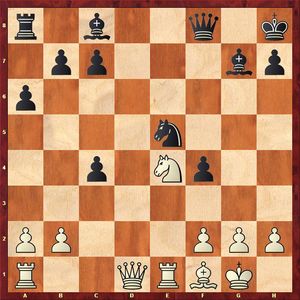
23.Ng5
This is a normal human type of reaction to the pending threat of the f4-f3 stab, which Anand does not want to see happening. However, objectively stronger was 23.Qd5 c6 24.Qd6 or 23.Rc1 f3 24.g3 Be6 25.b3; following the text move the game becomes equal.
23...Bf5 24.Qd5 c6 25.Qa5
The queen transfer to the edge of the board looks a bit strange, but White, oddly enough, finds the task of locating a good square for his strongest piece not an easy one.
25…b5! 26.Rad1?
This move, made to the best standards of the cut-and-dried practice, surrenders advantage to Black. A draw should have been forced via repetition of moves: 26.Qc7 (creating a threat of taking on е5 followed by delivering a check on f7) 26…Rc8 27.Qb7 Rb8 28.Qc7, etc.
26...Qe7! 27.Ne4 Rg8 28.Nd6 Bc2
Three excellent moves in a row have delivered the positional edge to Black.
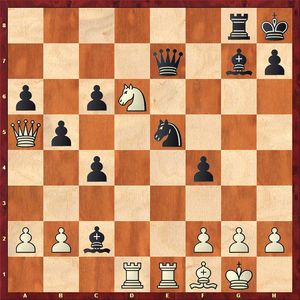
29.Qd2
White has to return the exchange as the rook retreat (29.Rd2 or 29.Rc1) runs into 29…Nf3+! followed by discovered check.
29...Bxd1 30.Qxd1 Rf8
30...Rd8? is refuted by 31.Rxe5! Bxe5 32.Nf7+ Qxf7 33.Qxd8+ Qg8 (33...Kg7? 34.Qg5+) 34.Qb6, and White should escape with a draw.
31.Ne4 f3 32.g3 Rd8 33.Qc1 Nd3
It made sense to have this lunge prepared via 33...Qd7 so as not to part with the с6-pawn.
34.Bxd3 cxd3 35.Qxc6 Bxb2 36.Kf1
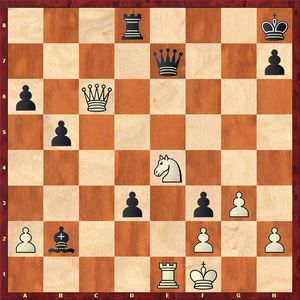
36…Qd7
Black could have continued playing with queens on the board (36...b4), but the first impression is that an endgame promises him an overwhelming kind of advantage.
37.Qxd7 Rxd7 38.Rd1 Rd5?
This is a loss of a tempo, while more straightforward is 38...b4 39.Nd2 a5 40.Nxf3 a4 41.Nd2 b3 42.axb3 a3 43.Nc4. White hangs on by the skin of his teeth, but meanwhile Black can bring the king into the center - 43...Kg7 44.f4 Kf6. Even though there is no doubt in the need for further analysis, it feels like White’s defenses are bound to crumble down somehow.
39.Nd2 b4 40.Nxf3 Bc3?!
After 40...Ra5 41.Rxd3 Rxa2 42.Ke2 a5 White should have yet come up with enough precision play to liquidate into a draw.
41.Ne1 d2
41...Ra5 was a better move once again.
42.Nf3 Ra5 43.Nxd2 Rxa2 44.Ne4 a5?!
Following 44...Rc2 45.Rd5 White is out of danger, but now it is Black who is fighting for a draw.
45.Nxc3 bxc3 46.Rc1
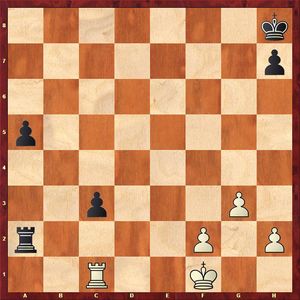
Being down to last seconds Shirov found a clear path to a draw nonetheless: 46…Ra3 47.Ke2 a4 48.Rc2 Rb3 49.Kd3 a3 50.Kc4
50.Rxc3? a2 is obviously bad for White.
50...a2 51.Rxa2 Rb2 52.Ra8+ Draw.
The other two games of round three also ended in a draw, although Kramnik had excellent winning chances against Nakamura, but still the American grandmaster managed to salvage a half point. As for round four, in which Vladimir’s wife and daughter came to lend him their support, he finally won his game.
Kramnik – Giri
Vladimir Kramnik first tied Black’s forces to defending the weak c6-pawn, and then went on to break up the center in his trademark style.
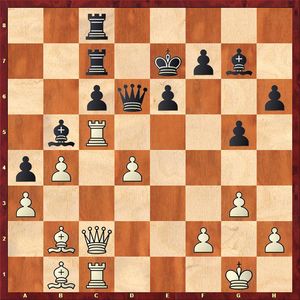
33.Re1! Kf8 34.d5! e5
White’s d5-pawn can be captured by neither of the two Black’s pawns: 34...cxd5 35.Bxg7+ Kxg7 36.Qh7+ Kf8 37.Rxb5 or 34...exd5 35.Bxg7+ Kxg7 36. Qh7+ Kf8 37. Qh8#. Finally, 34...Bxb2 35.Qxb2 is hopeless eihter.
35.Rc1 Bf6 36.Qf5 Bg7 37.dxc6 Bxc6
White would meet 37...Rxc6 with the same idea as was carried out in the game: 38.Qxc8+! Rxc8 39.Rxc8+ Ke7 40.Bf5 with decisive threats.
38.Qc2 Qe6
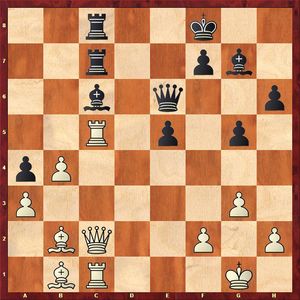
39.Qf5
The resourceful Anish Giri prepared to meet 39.b5? with a worthy rejoinder 39...Be4! However, Kramnik does not fall into this nice trap.
39...Qd6 40.Ba2
According to the engine stronger was 40.Qd3, but the intricate geometry of this position does not allow for its easy interpretation with limited time for thinking. Kramnik decides to launch an offensive against the king.
40...Be8 41.Qxc8! Rxc8 42.Rxc8 Qd2
More stubborn was 42...e4, but following an exemplary continuation 43.Bxg7+ Kxg7 44.Rxe8 Qd2 45.Rf1 White would still feature substantial winning chances. It my memory serves me right, Kramnik won from Leko an ending with similar balance of material in one of the match games.
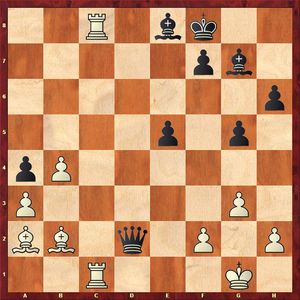
43.R1c7 Qxb2 44.Rxf7+
44.Bxf7 Qb1+ 45.Kg2 Qe4+ 46.f3 Qe2+ 47.Kh3 Qf1+ 48.Kg4 h5+ 49.Bxh5 was another good alternative.
44...Kg8 45.Rxe8+ Kh7 46.Bd5 Black resigns.
The score of victories was opened by Levon Aronian who defeated Alexei Shirov in the Berlin endgame with the black pieces. Anand played as Black against Nakamura and retained his leading position prior to the final day of the tournament.
On Sunday Anatoly Karpov happened to be one of the tournament commentators. It has not been so often in the course of the recent years that the 12th World Champion used to discuss the events taking place directly on the chess board, and it was therefore ever so much more interesting to listen to him.
















